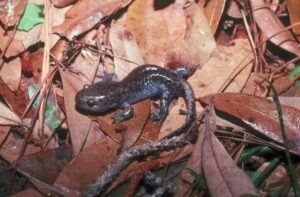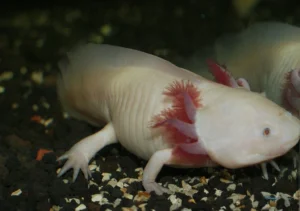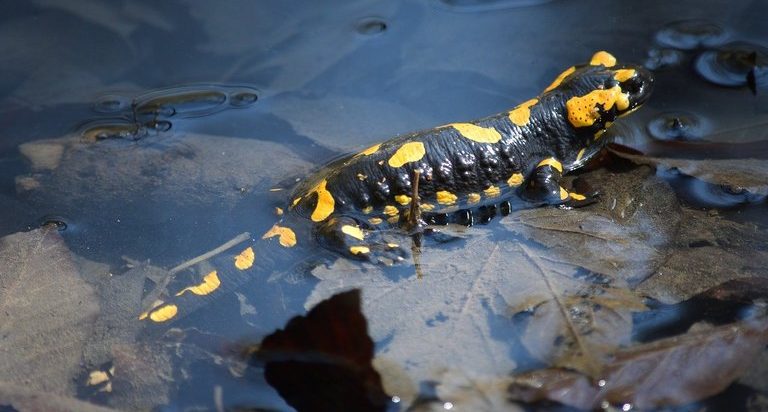If you’ve ever seen a salamander near a pond or found one under a log in the forest, you might wonder; do salamanders actually live in water?
The simple answer is: some do, some don’t. Many salamanders spend part of their lives in water, especially when they’re young. Others live mostly on land but return to water only to lay their eggs. And some, like the axolotl, spend their entire lives underwater. It all depends on the species.
Salamanders are Amphibians
Salamanders are amphibians, like frogs and toads.
They belong to a group of animals called Caudata, and they’re known for their soft, moist skin, short legs, and long tails.
Some are small and plain-looking, while others are brightly colored with striking patterns.
There are around 740 species of salamanders in the world. Some live in cool mountain streams.
Others hide under leaves in damp forests. Each species has its own way of life, and its own favorite kind of home.
Most Salamanders start their lives in the water
Most salamanders start their lives as tiny embryos inside an egg sack. These embryos will develop until they are ready to hatch into the water, typically in three to four weeks.
After hatching, the baby salamanders (larvae) will live a fully aquatic life and have external feathery gills attached to either side of their head, just where their necks should have been.

They use these gills to breathe underwater, just like fish.
After a few months, to as long as three years in some species, the larvae will go through a process known as metamorphosis and transform into adults.
During metamorphosis, they will lose their gills and develop limbs for walking on land.
Most Adult Salamanders Live on Land
After metamorphosis, most salamanders live on land.
Life on land isn’t easy, so salamanders have found smart ways to cope.
Their skin has to stay wet so they can keep breathing through it. That’s why many of them hide in damp places, under rotting logs, inside cracks in rocks, or buried in leaves.

They even have special skin glands that make protective slime. Others hide in burrows or stay hidden during dry weather to keep from drying out.
Moving to land also means growing up. This is when most salamanders become adults and start looking for mates.
Courtship can get fancy, with slow dances, scent signals, and even guarding their space.
Many still go back to water just to lay eggs, tying their adult lives on land to the watery world they came from.
Some Adult Salamanders Are Fully Aquatic
Even though most adult salamanders live on land, a few species have taken a very different path.
Some salamanders stay in the water their entire lives. They never leave. This is a fascinating twist in how amphibians live, and it goes against the usual pattern.

These fully aquatic salamanders include some of the most unusual members of the salamander family like;
- The axolotl from Mexico
- The mudpuppy in North America
- The giant salamanders found in Asia
These water-living salamanders don’t just swim, they keep many of their baby features forever. This is called neoteny.
Even as adults, they keep their fluffy gills, their sensing lines along the sides, and other traits that help them live well in water. But they can still reproduce.
This way of living gives them a full-time edge in the water. They grow bigger, move differently, and take over roles that land salamanders can’t.
Living only in water comes with some real advantages. Water stays more stable, it doesn’t get too hot or too dry.
It offers steady food, like fish, bugs, and small water animals. And there are fewer land predators to worry about.
Because the water holds them up, these salamanders can grow much bigger than their land-based cousins.
One example (the Chinese giant salamander) can grow over five feet long and weigh more than 60 pounds.
Why Moisture Matters
Whether a salamander lives in water, on land, or in between, one thing stays the same, they all need moisture.
A salamander’s skin is soft and unprotected, and it must stay damp to help with breathing and hydration.
That’s why you’ll rarely see a salamander in dry, sunny areas.
They’re most active at night, early in the morning, or after a rainstorm when the air is humid and the ground is damp.
Salamanders and Survival
This ability to live in so many different places makes salamanders incredibly versatile.
Their behavior often changes based on the weather, the season, or the availability of food.
If a pond dries up, a semi-aquatic salamander can often move into the forest nearby and wait for better conditions.
But even with these amazing adaptations, salamanders are still vulnerable to environmental threats.
Why Habitat Conservation Matters
Salamanders play an important role in nature. They help control insect populations, and they’re also a food source for birds, snakes, and mammals.
Because they are sensitive to changes in their environment, salamanders are also a sign of ecosystem health.
Unfortunately, salamanders face many challenges today. Their habitats are disappearing because of deforestation, pollution, climate change, and urban development.
When forests are cleared or wetlands are drained, salamanders have nowhere to go.
Invasive species, like certain fish or frogs, can also eat salamander eggs and larvae, reducing their numbers.
And when chemicals like pesticides enter the water or soil, they can harm salamanders through their delicate skin.
How We Can Help
Protecting salamanders means protecting their homes. This includes:
- Keeping forests, streams, and wetlands intact
- Avoiding the use of harmful chemicals
- Leaving logs, rocks, and leaf litter undisturbed
- Supporting local conservation efforts
- Educating others about these amazing creatures
Even small actions, like not disturbing wild salamanders or reporting sightings for research, can make a difference.
Conclusion
So, do salamanders live in water? Yes, many do. But not all of them stay there. Some only return to water to lay eggs. Others skip the water stage altogether. And some species go back and forth, adjusting their habits with the seasons.
Salamanders are experts at surviving in damp forests, cool streams, and hidden places where few other creatures can live.
Their world might be quiet and damp, but it’s also full of surprises, if you know where to look.
Hi, my name is Ezra Mushala, i have been interested animals all my life. I am the main author and editor here at snakeinformer.com.

